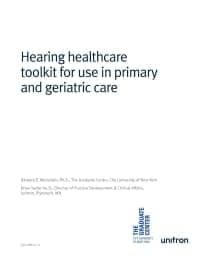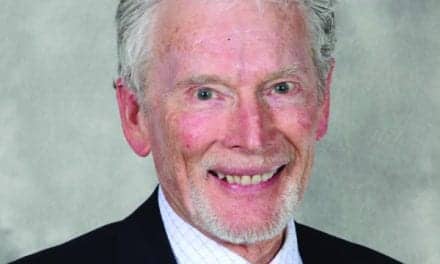Opinion | Patient Care
The transition from a traditional, paternalistic, and provider-focused system to a model that considers patients as active partners in their own care is the next big challenge.
The idea of implementation is absolutely crucial to the next iteration of person-centered care (PCC) thinking. PCC 2.0 will be about working together across stakeholders to ensure the transition from the traditional healthcare delivery model to a model that truly values and considers the patient’s perspective.
Person-centered care
(PCC) has been on the hearing care agenda for quite some time. While evidence for PCC is building—and healthcare providers and systems seem to have realized its necessity—the question of how to implement PCC in practice and ensure that patients have a strong voice in their own treatment remains the main challenge. In fact, one might think of this as the “next step” for person-centered care, or PCC 2.0.
A Paradigm Shift
In June 2019, the Organization for Economic Cooperation and Development (OECD) launched a major study titled Putting People at the Centre of Healthcare.1 As its name indicates, the study aims to strengthen the capacity of health systems to deliver person-centered services and examine how to systematically measure and collect data on what matters most to patients.
The study demonstrates the growing commitment of policy makers to put PCC on the healthcare agenda. It is the latest addition to a long series of reports, research projects, and articles testifying to the topicality and growing awareness of the positive impact of PCC on patient outcomes and satisfaction—and on healthcare costs.
The Ida Institute, an organization involved in facilitating understanding of the human dynamics of hearing loss, has been following the development of PCC in hearing care closely for the past decade. There is no doubt a paradigm shift towards an increased recognition of PCC in the hearing care arena is occurring—a development accelerated in recent years with the emergence of over-the-counter sales, technical innovations, and changing consumer behaviors and attitudes.
When we started the Ida Institute 12 years ago, the concept of PCC in hearing care was still relatively vague. In fact, some hearing care professionals tended to relegate the topic of PCC to a nebulous “touchy-feely” branch of aural rehabilition—one that had few identifiable tenets or concrete protocols and recommendations for implementation in a real practice. However, there were a number of academics and dedicated practitioners around the world working to develop PCC practices, but they were mostly working alone.
PCC in Hearing Care: From Add-on to Value-added
The Ida Institute was successful in bringing together many of these expert “PCC front-runners” to collaborate on the development of new, innovative methods and tools to enable hearing care professionals to apply PCC in their practices. Many of the resources have become textbook references, such as Ida’s Motivation Tools and Communication Partner tools. More recently, interest in these tools has really picked up. The demand for our resources has increased considerably, as has the number of research projects, articles, and references to PCC in hearing care generally.
In recent years, PCC principles have been integrated in national clinical standards and guidelines. Specifically in the area of hearing care, examples include the National Institute for Health and Care Excellence (NICE) 2018 Guidelines Hearing Loss in Adults: Assessment and Management2 in the UK, and the 2015 Official Recommendations of the Committee for VA Audiology and Speech-Language Pathology3 in the United States.
PCC is also increasingly acknowledged by various professional organizations. Tai et al,4 in a paper published in the International Journal of Audiology, notes that “the British Society of Audiology has provided practice guidelines to incorporate client-centred care to facilitate the hearing rehabilitation process. The American Speech-Language Hearing Association (ASHA) has incorporated counseling skills as part of audiologists’ scope of practice…”5,6 Examples also include Audiology Australia’s Strategic Plan for 2018-23 which aims to “enable and support our members to practice contemporary, family and person-centred care to a recognized set of professional and ethical standards to foster trust amongst those that need audiology services.”7
What we are witnessing is a paradigm shift brought on by the necessity for the hearing care profession to reinvent itself. Across the profession, people seem to realize that PCC is not an “add-on,” but a true “value add.”
PCC 2.0: The Challenge of Making it Happen
Despite the increased awareness of PCC across the global hearing care arena, the actual implementation of a person-centered approach by healthcare systems and providers is lagging. The transition from a traditional, paternalistic, and provider-focused system to a model that considers patients as active partners in their own care seems to be a challenge.
In February 2019, the Economist Intelligence Unit launched a research report and white paper looking at the transition towards PCC.8 The reports examine the key factors that the 9 participating countries should consider to better integrate PCC. They conclude that while all 9 countries have a strategy or national plan for PCC in place, the “transition from disease-focused to patient-centred models, where patients are participants in the decision-making process, is slow.”
In effect, the issue of how to ensure the transition from theory to practice appears to be the most important question today. To achieve this transformation requires profound changes in our healthcare systems, in our educational systems, and in the way we deliver and perceive change.
In my opinion, the notion of implementation is absolutely crucial to the next iteration of PCC thinking. PCC 2.0 will be about working together across stakeholders to ensure the transition from the traditional healthcare delivery model to a model that truly values and considers the patient’s perspective. It’s about building partnerships and alliances that will enable us to bridge the gap between thought and action. Importantly, it will also become an integral part of what in the United States is being called “value-based” or “outcomes-based” medicine.9
The idea of joining forces to bridge the gap between thought and action is also behind the Ida Institute’s recent initiative to invite professional bodies, patient organizations, universities, and partner clinics to join the Person-Centered Hearing Network (PCHN). The purpose of PCHN is to create a coalition of organizations and individuals working together to make PCC a reality in hearing care around the world through knowledge sharing and collaboration.
But the notion of partnership also applies on a more fundamental, cultural level. Making PCC happen requires a shift in the way we perceive care—both from a professional and patient perspective. Ensuring that the patient has a strong voice in their own care requires that we consider hearing care as a partnership between the professional and the patient. Once we have managed to create that understanding, we will have come very far. ?
References
-
Organization for Economic Cooperation and Development (OECD). Putting People at the Center of Health Care. PaRIS Survey of Patients with Chronic Conditions. 2019. Available at: http://www.oecd.org/health/health-systems/PaRIS-survey-Patients-with-Chronic-Conditions-June-2019.pdf
-
National Institute for Health and Care Excellence (NICE). Hearing loss in adults: assessment and management. June 2018. Available at: https://www.nice.org.uk/guidance/ng98
-
Veterans Administration. Official Recommendations of the Committee for VA Audiology and Speech-Language Pathology. 2015.
-
Tai S, Barr C, Woodward-Kron R. Competing agendas and other tensions in developing patient-centred communication in audiology education: a qualitative study of educator perspectives. Int J Audiol. 2018 Apr;57(4):274-282. Available at: https://www.ncbi.nlm.nih.gov/pubmed/28990797
-
British Society of Audiology. Practice Guidance Common Principles of Rehabilitation for Adults in Audiology Services. October 2016. Available at: http://www.thebsa.org.uk/wp-content/uploads/2016/10/Practice-Guidance-Common-Principles-of-Rehabilitation-for-Adults-in-Audiology-Services-2016-3.pdf
-
American Speech-Language Hearing Association (ASHA). Person- and Family-Centered Care. Undated. Available at: https://www.asha.org/Practice-Portal/Clinical-Topics/Aphasia/Person-and-Family-Centered-Care
-
Audiology Australia. Audiology Australia Strategic Plan 2018-23. November 2018. Available at: https://audiology.asn.au/Tenant/C0000013/Media%20Releases/ audaus-strategic-plan-1118%20(002).pdf
-
Beagley J, et al [as part of The Economist Intelligence Unit]. Adoption of Patient-Centred Care: Findings and Methodology. 2019. Available at: https://patientcentredcare.eiu.com/research-report.pdf
-
Kauffman L. Hearing and Value-based Healthcare. 2018. Available at: https://hearingreview.com/2018/03/special-report-hearing-care-value-based-reimbursement-medicine

is managing director of the Ida Institute in Naerum, Denmark.
Correspondence can be addressed to: [email protected]





